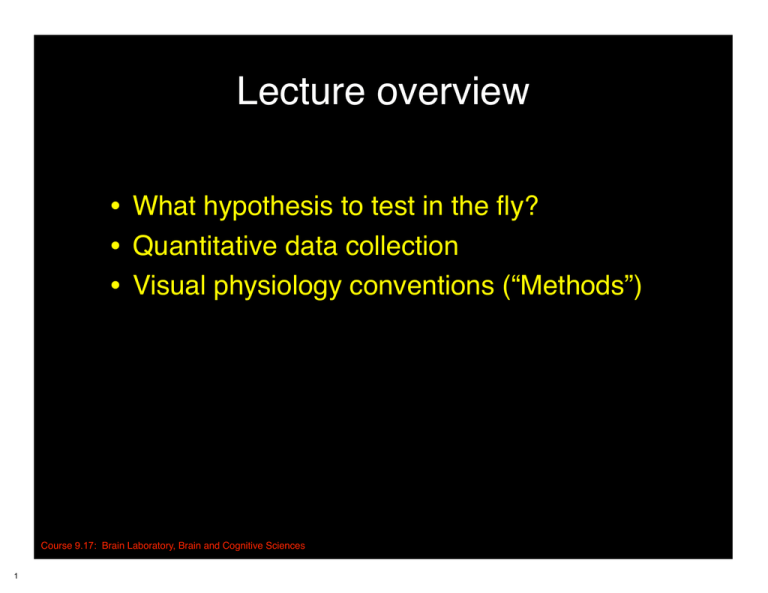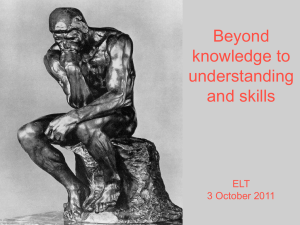
Lecture overview
• What hypothesis to test in the fly?
• Quantitative data collection
• Visual physiology conventions (“Methods”)
Course 9.17: Brain Laboratory, Brain and Cognitive Sciences
1
Lecture overview
• What hypothesis to test in the fly?
• Quantitative data collection
• Visual physiology conventions (“Methods”)
Course 9.17: Brain Laboratory, Brain and Cognitive Sciences
2
“Encoding”
Stimuli
“Decoding”
Neuronal codes
Behavior
General situation in vision encoding studies:
Independent variable: pattern of photons
Dependent variable: pattern of spikes from one or
more neurons
A specific case (e.g. for H1 in the fly):
Independent variable: direction of a moving grating
Dependent variable: spike rate during each the
presentation of each grating
spikes per unit time (spikes/sec)
Course 9.17: Brain Laboratory, Brain and Cognitive Sciences
3
Overall goal of the fly labs: the basics of carrying out a
complete, quantitative neurophysiology experiment.
• Design visual stimuli to test a
hypothesis
• Setup a prep to record from
relevant
neurons
A hypothesis
or description about
the relationship
between
visualin a
your visual
stimuli
• Present
controlled,
manner
stimuli and arepeatable
neuronal response
• Collect digital data during that
presentation
• Isolate individual spikes in that data
• Analyze the relationship between
spike responses and visual stimuli
• Document your findings
Course 9.17: Brain Laboratory, Brain and Cognitive Sciences
4
MATLAB proj 2
Design lab
FLY wet lab 1
FLY wet lab 2
FLY wet lab 2
MATLAB proj 1
MATLAB proj 3
Data analysis lab
Lab Report 2
Example of quantitative neurophysiology:
orientation tuning a neuron in primary visual cortex
(area V1) of the monkey.
Function fit to
the average
responses
One of our overarching goals is to teach
you how these kind of plots are produced.
You will do all the steps yourself!
From Dayan, Peter, and L. F. Abbott. Theoretical Neuroscience: Computational and Mathematical Modeling
of Neural Systems. MIT Press, 2001. © Massachusetts Institute of Technology. Used with permission.
Course 9.17: Brain Laboratory, Brain and Cognitive Sciences
5
Lecture overview
• What hypothesis to test in the fly?
• Quantitative data collection
• Visual physiology conventions (“Methods”)
Course 9.17: Brain Laboratory, Brain and Cognitive Sciences
6
Basic electrophysiological setup
Photon stimulation
(retinal receptors)
Analog to
digital device
(A to D)
LCD screen
trigger pulse (start A to D)
Display
computer
Synchronization pulses
Course 9.17: Brain Laboratory, Brain and Cognitive Sciences
7
Data
collection
computer
We must have some way of saving the voltage signal
so that we can find the spikes (action potentials) later
A single action
potential
Analog
Analog to digital
device (A to D)
Digital
Number of samples taken every second:
(1 kHz sampling)
2000
(2 kHz sampling)
4000
(4 kHz sampling)
What sampling rate is optimal?
1 ms (1/1000 sec)
Reprinted by permission from Macmillan Publishers Ltd: Nature.
Source: Hodgkin, A. L., and A. F. Huxley. "Action Potentials
Recorded from Inside a Nerve Fibre." Nature 144
(1946): 710-11. © 1946.
Course 9.17: Brain Laboratory, Brain and Cognitive Sciences
8
1000
Are there downsides to sampling faster?
*Sample at 2x the highest frequency in the signal to
get a perfect reproduction of the signal (= “Nyquist
sampling rate”).
Basic electrophysiological setup
Photon stimulation
(retinal receptors)
Analog to
digital device
(A to D)
LCD screen
trigger pulse (start A to D)
Display
computer
Synchronization pulses
Course 9.17: Brain Laboratory, Brain and Cognitive Sciences
9
Data
collection
computer
We must have some way of aligning (synchronizing)
the visual stimulus with the recorded voltage
0 ms 1500 ms
2500 2900 ms
Visual stimulus:
Voltage near
neuron:
spikes per unit time (spikes/sec)
Times of action
potentials (‘spikes’):
Course 9.17: Brain Laboratory, Brain and Cognitive Sciences
10
First steps to quantitative physiology (science):
• Ability to accurately repeat conditions.
• Control of variables -- only change one thing
at a time!
Stimulus run 1:
Stimulus run 2:
Course 9.17: Brain Laboratory, Brain and Cognitive Sciences
11
Example voltage traces
Stimulus:
Voltage near
neuron on run 1:
Voltage near
neuron on run 2:
Course 9.17: Brain Laboratory, Brain and Cognitive Sciences
12
103 ms
23 ms
56 ms
SpikeTimesMS{1} = [ 23 56 103 ... ]
...
SpikeTimesMS{2} = [ 10 12 150 160 175 ... ]
SpikeTimesMS{10} = [ ... ]
Course 9.02: Brain Laboratory, Brain and Cognitive Sciences
13
Spike sorting:
You learned how to so spike detection in Matlab Tutorial 1. However, that was relatively
clean data. Your data file may be much messier and may contain many artifacts that you
should try to deal with. For example, if the fly moves, this creates a lot of noise in the
voltage trace, and a simple spike detector might count this noise as spikes. Thus, you
should NOT blindly run a spike detector, but should examine your data closely and make
sure the spike detector is doing something reasonable.
Course 9.17: Brain Laboratory, Brain and Cognitive Sciences
14
mV
Another spike
waveform
Your spike
waveform of
interest
time (sec)
Course 9.17: Brain Laboratory, Brain and Cognitive Sciences
15
Also, look out for noise bursts !
H1 cell
Post-stimulus time histogram (PSTH)
Figure 4 removed due to copyright restrictions. Eckert, Hendrik. "Functional Properties of the HI-Neurone in the Third Optic
Ganglion of the Blowfly, Phaenicia." Journal of Comparative Physiology A 135, no. 1 (1980): 29-39. 10.1007/BF00660179.
Course 9.17: Brain Laboratory, Brain and Cognitive Sciences
16
Neuronal spiking is variable:
“Post-stimulus
spike histogram”
“Spike rasters”
Course 9.17: Brain Laboratory, Brain and Cognitive Sciences
17
What is a key analysis parameter here?
What are key underlying assumptions that allow us
to collapse the 10 trials together?
“Post-stimulus
spike histogram”
“Spike rasters”
Course 9.17: Brain Laboratory, Brain and Cognitive Sciences
18
If you compute a histogram for each of
your conditions, you get this…
Effect of each
condition on mean
firing rate
mean
over
what?
Matlab project3 due a week from Tuesday
Course 9.17: Brain Laboratory, Brain and Cognitive Sciences
19
Example of quantitative neurophysiology:
orientation tuning a neuron in primary visual cortex
(area V1) of the monkey.
Function fit to
the average
responses
One of our overarching goals is to teach
you how these kind of plots are produced.
You will do all the steps yourself!
From Dayan, Peter, and L. F. Abbott. Theoretical Neuroscience: Computational and Mathematical Modeling
of Neural Systems. MIT Press, 2001. © Massachusetts Institute of Technology. Used with permission.
Course 9.17: Brain Laboratory, Brain and Cognitive Sciences
20
‘Direction-of-reach’ tuning curve for a neuron in
primary motor cortex (area M1) of the monkey.
From Dayan, Peter, and L. F. Abbott. Theoretical Neuroscience: Computational and Mathematical Modeling
of Neural Systems. MIT Press, 2001. © Massachusetts Institute of Technology. Used with permission.
Course 9.17: Brain Laboratory, Brain and Cognitive Sciences
21
Can we make a
tuning curve?
R Desimone, TD Albright, et al. "Stimulus-Selective Properties of Inferior Temporal Neurons in the Macaque."
The Journal of Neuroscience 4, no. 8 (1984): 2051-62. Available under Creative Commons BY-NC-SA.
Course 9.17: Brain Laboratory, Brain and Cognitive Sciences
22
Tuning curves: what are they good for?
• Show the data (nice summary)
• Describe trends in the data (function fit)
• Predict response to other stimuli ?
• Describe the neuron’s role in behavior ???
Tuning curves: downsides
Emphasize mean firing rates. Msec-scale
timing of individual spikes is ignored
Not everything we are interested in can be
plotted along a single axis
Course 9.17: Brain Laboratory, Brain and Cognitive Sciences
23
Neuronal spiking is stochastic. Why?
Stimulus:
Voltage near
neuron on run 1:
Voltage near
neuron on run 2:
Course 9.17: Brain Laboratory, Brain and Cognitive Sciences
24
Lecture overview
• What hypothesis to test in the fly?
• Quantitative data collection
• Visual physiology conventions (“Methods”)
Course 9.17: Brain Laboratory, Brain and Cognitive Sciences
25
Standard units of visual stimuli
Distance on retina:
1 millimeter
Screen distance: 1.5 meters
3.5-degree
angle
Distance on screen:
89 millimeters
Rays of light
Image by MIT OpenCourseWare.
Stimulus size: degrees of visual angle (deg)
E.g. “The white square subtended approximately 4 deg x 4 deg of
visual angle”
Speed of motion: degrees of visual angle covered per
unit time (deg/sec)
E.g. “The white square was moved from left to right at a speed of
40 deg/s.”
Course 9.17: Brain Laboratory, Brain and Cognitive Sciences
26
deg (elevation)
Standard units of visual stimuli:
receptive field maps in vertebrates
Size (diameter)
of receptive field
© MGraw-Hill Companies. All rights reserved. This content is
excluded from our Creative Commons license. For more
information, see http://ocw.mit.edu/help/faq-fair-use/.
0
Center of gaze (center
of the retina)
0
deg (azimuth)
Course 9.17: Brain Laboratory, Brain and Cognitive Sciences
27
Center of
receptive field
deg (elevation)
Standard units of visual stimuli:
receptive field map
0
0
deg (azimuth)
Course 9.17: Brain Laboratory, Brain and Cognitive Sciences
28
Receptive field
of a neuron
Center of visual axis of
the fly
MOTION-SENSITIVE
MO
motion RF of the H1 neuronThe V1 neuron
elevation (deg)
your monitor?
azimuth (deg)
FIGURE 8. Response fields of the neur
FIGURE 8. Rsponse hemisphere
fields of the
neurons c,Hlcaudal;
(a) andd, Vl
(f, frontal;
dor
hemisphere (f, frontal;
c,
caudal;
d,
dorsal,
v,
ventral).
The
of 0 deg.
Local
Krapp and elevation
Hengstenberg,
Vision
Res. motion
(1997) tuning
elevation of 0 deg. Local
motion
tuning
(obtained
with stan
indicates the local preferred direction
Courtesy of Elsevier, Inc., http://www.sciencedirect.com. Used with permission.
Course 9.17: Brain Laboratory, Brain and Cognitive Sciences
29
Fly visual field: state your conventions!
Course 9.17: Brain Laboratory, Brain and Cognitive Sciences
30
Luminance
Course 9.02: Brain Laboratory, Brain and Cognitive Sciences
31
Luminance
Contrast
Course 9.17: Brain Laboratory, Brain and Cognitive Sciences
32
Basic units of visual stimuli
- luminance: amount of light (~photons) emitted from a
particular area per unit time (units: candela/m )
2
- contrast: range of luminance relative to the total
luminance (e.g. Michelson contrast = ( Lmax - Lmin ) / (Lmax + Lmin) )
For your lab report:
assume that your display monitor has:
maximum luminance of 100 cd/m2 (full white, pixel value = 255 in Matlab matrix)
minimum luminance of 1 cd/m2 (deepest black, pixel value = 0 in Matlab matrix)
Course 9.17: Brain Laboratory, Brain and Cognitive Sciences
33
MIT OpenCourseWare
http://ocw.mit.edu
9.17 Systems Neuroscience Lab
Spring 2013
For information about citing these materials or our Terms of Use, visit: http://ocw.mit.edu/terms.





